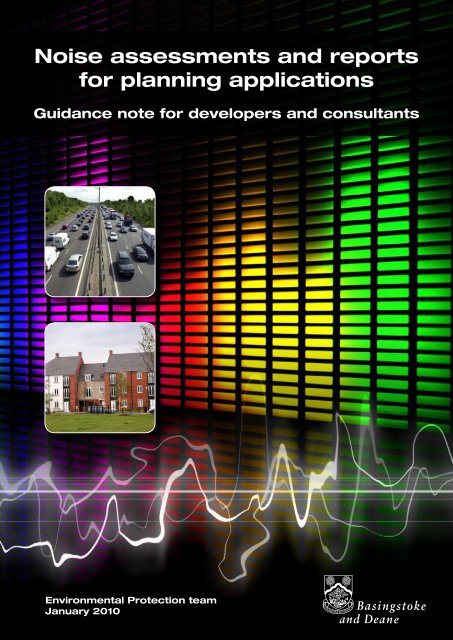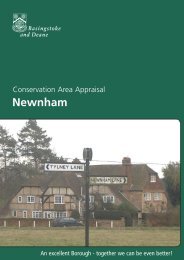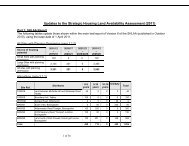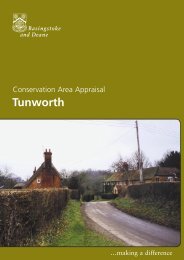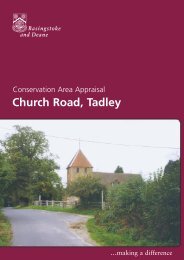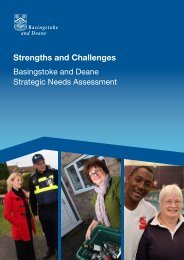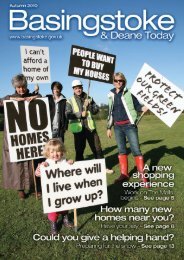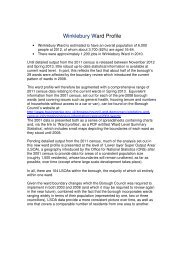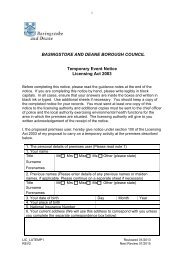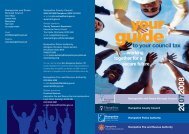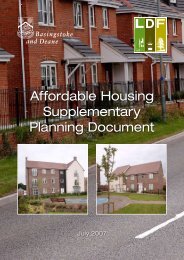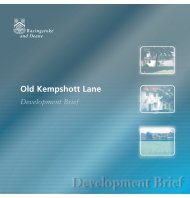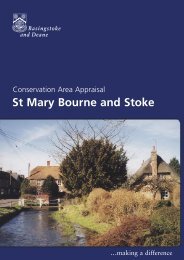Environmental Protection - Basingstoke and Deane Borough Council
Environmental Protection - Basingstoke and Deane Borough Council
Environmental Protection - Basingstoke and Deane Borough Council
Create successful ePaper yourself
Turn your PDF publications into a flip-book with our unique Google optimized e-Paper software.
calculation. Occasionally the council may ask for a post-completion noise assessment toprove that the finished development achieves the criteria. Acceptability criteria varyaccording to the type of receptor, many of which are set out in British St<strong>and</strong>ards or otherguidance (see Appendix 3). Sometimes the council will have its own criteria, usually setout in planning guidance.The council will expect noise assessment work to be carried out by an individual (usually anoise consultant) or firm (noise consultancy) which has the necessary qualifications <strong>and</strong>accreditation. Details of the organisations are listed later in this guidance.The report submitted should set out all the required information in a format which is logical<strong>and</strong> underst<strong>and</strong>able. It should provide the council with information required about theconsultant, equipment used, agreed criteria, surveys undertaken, noise source, receptors<strong>and</strong> the impact. The suggested structure <strong>and</strong> content of the report is set out later in thisguidance.The process of completing a successful noise assessment involves:(a)(b)(c)(d)(e)(f)(g)discussing with the council the need for <strong>and</strong> timing of an assessmentselecting <strong>and</strong> appointing an acoustic consultantthe noise consultant discussing <strong>and</strong> agreeing criteria to be achieved <strong>and</strong> sources<strong>and</strong> receptors to be consideredcarrying out noise measurement surveyassessing the impact of noise sources at receptorsspecifying mitigation measures if necessary to achieve agreed criteria <strong>and</strong>reassess impactpreparing a detailed report(a)Discussion with the councilIn most cases applicants will have initially spoken to the council’s developmentcontrol team about their application. Applicants may then be referred to theenvironmental protection team for a more detailed pre-application discussion aboutthe potential noise impacts of, or on, the proposed development.If you think your proposal may have a noise impact, or be affected by noise, youshould contact the environmental protection team on 01256 844844.This is an opportunity to outline the proposed development <strong>and</strong> any noise concernswhich you or the council can identify.For proposals where noise is likely to be a key consideration in whether planningpermission may be granted, the council will require a noise assessment to becarried out <strong>and</strong> a report to be submitted along with the planning application. Wherenoise is not likely to be a determining issue, the council may impose a planningcondition on the permission requiring an assessment to be carried out at that stage.If the proposal is simple, the council can advise you of the acceptability criteria itwants achieved when the development is complete. The information should be3
passed to the noise consultant, although a more detailed discussion with theconsultant may be necessary particularly if the project is large scale or complex.(b)Select a noise consultantIt is important to engage an appropriately qualified consultant as the council maynot accept their assessment <strong>and</strong> report if it is not produced correctly.Most responsible noise consultants will be members of the Institute of Acoustics,although not all members will be experienced noise consultants. For example,some may be academic noise specialists. However, all members of theAssociation of Noise Consultants should be experienced practising consultants whocan undertake the work required. At Appendix 2 of this guidance you will findcontact details for both organisations to help you find members operating in yourarea <strong>and</strong> for your type of application.A reputable noise consultant will use instruments meeting the minimum requiredspecifications <strong>and</strong> will have up to date certification. When the council receives theconsultant’s report it will be checked to ensure evidence on the types of instrumentused is provided <strong>and</strong> to ensure it has an up-to-date calibration certificate. Thebasic requirements are as follows:• Instrument typeMost consultants will use integrating sound level meters conforming toBS 6698/IEC 61672 Class 1. This is preferred, but as a minimum the instrumentshould be of Class 2.• Evidence of instrument responseThe instrument shall be calibrated to the manufacturer’s st<strong>and</strong>ard or by aNational Accreditation of Measurement <strong>and</strong> Sampling (NAMAS) accreditedlaboratory within the previous two years. A current certificate of calibrationshould be available <strong>and</strong> a copy included in the assessment report.The response of the instrument should be checked before <strong>and</strong> after eachmeasurement using a field calibrator. Any calibration drift shall be recorded <strong>and</strong>reported. The portable calibrator should itself have been checked <strong>and</strong>, ifnecessary, be recalibrated to the manufacturer’s st<strong>and</strong>ard or by a NAMASaccredited laboratory within the previous 12 months. A current certificate ofcalibration should be available <strong>and</strong> a copy included in the assessment report.(c)Establishing noise sources, receptors <strong>and</strong> acceptability criteriaThe noise consultant should be familiar with the noise assessment process, butshould be advised to discuss the proposal in detail with the environmentalprotection team. In particular, the following should be established:• The principal existing or proposed noise sources (if this is not obvious). Thecouncil may be able to help identify existing local sources of noise.• When the sources operate or are likely to be operating (time of day <strong>and</strong> days ofthe week). The council may have knowledge about local sources <strong>and</strong> the timesthey operate.4
• Where <strong>and</strong> what type of sensitive receptors are likely to be affected by theproposal. The council may be able to help identify the location of existingsensitive receptors.• The acceptability criteria the council requires to be achieved. The criteriacommonly used for different situations is set out in Appendix 3. However it isworth confirming your underst<strong>and</strong>ing of these with the environmental protectionteam.• The methodology the council expects will be used in the survey <strong>and</strong> assessment.The methodology applied will depend on the purpose of the survey <strong>and</strong> thesource of noise under consideration. Any st<strong>and</strong>ard method may have limitedapplicability <strong>and</strong> may not entirely meet the objectives in each case. A methodstatement should be submitted to the environmental protection team at least twoweeks prior to the survey.(d)Noise measurement surveyA survey will usually be necessary to measure noise levels arising from existingnoise sources, where these may affect receptors in your development, <strong>and</strong> whenthere is a need to underst<strong>and</strong> the existing background or baseline noise situation.The noise consultant will be aware of the requirements for surveys <strong>and</strong> will need toensure that the following practices are observed:Weather conditionsNoise measurements can be influenced by weather conditions. The survey mustbe carried out in suitable conditions, for example in the absence of strong winds,rain or snow. Where traffic noise is concerned, road surfaces should be dry. Themicrophone of the sound level meter should be fitted with a windshield whenoutdoor measurements are taken <strong>and</strong> details of weather conditions during thesurvey should be given in the report. The report should include a location planshowing measurement positions in relation to the development site.Attendance at surveyIt is preferred that surveys are attended by the consultant, so they can be certain ofthe origins of the noise measured <strong>and</strong> recorded. On occasions, when long-termunattended measurements are needed, these should be supplemented at certaintimes with attended measurements for the consultant to be able to account for thevariations seen in the record.Recording survey informationMost noise measuring equipment now records <strong>and</strong> stores data. However, it is alsoimportant to make a written record of other aspects of the survey such as:• purpose, dates, times <strong>and</strong> duration• personnel present• calibration data• instruments <strong>and</strong> techniques used• st<strong>and</strong>ards employed5
• key results, noise indices, time <strong>and</strong> frequency weightings <strong>and</strong> instrument filenumbers• weather conditions• ground conditions• source variability <strong>and</strong> description, worst <strong>and</strong> typical situations <strong>and</strong> interferences• layout plan showing sources, receptors, measurement positions <strong>and</strong> distances(e)Impact assessmentThe noise consultant will underst<strong>and</strong> or have agreed with the environmentalprotection team the appropriate way to carry out a noise impact assessment.Baseline situationBefore any judgement can be made on the likely impact of a development, it willusually be necessary to have a full underst<strong>and</strong>ing of the existing noise in thevicinity of the receptor. This is achieved by carrying out a survey of background orambient noise levels over periods of time representative of the times <strong>and</strong> dayswhen the noise source will be operational.Depending on the assessment method used, the baseline will usually bedetermined by measuring the L A90 or the L Aeq. In practice both will usually bemeasured simultaneously.The L A90 is the ‘A’ weighted noise level exceeded for 90% of the measurementperiod. Typically this is called the background noise level if it relates to a periodwhen the noise source is not operational. The ‘A’ weighting is a correction appliedwithin a sound level meter to adjust the response of the meter to match theresponse of human hearing at different frequencies. This approach is used toexclude short-term noises, such as a vehicle passing, from the measurement value,leaving only the underlying or background noise.The L Aeq is as an average noise level over the measurement period, althoughstrictly speaking it relates to the average noise energy. It is a popular <strong>and</strong>universally used measure which correlates well with human annoyance.Noise sources <strong>and</strong> times of operationA detailed knowledge of the noise source (or in the case of a proposeddevelopment, the likely noise source) is also essential. This is because noiselevels are of less importance than the amount by which they exceed the baselinenoise <strong>and</strong> the times or days of operation.Where the noise source already exists, data from the survey should giveinformation about levels, frequency content <strong>and</strong> variability during <strong>and</strong> betweendays. Levels may be measured at the proposed receptor location or calculatedlater from source data at a different location.6
If the proposed development will create a source of noise, the consultant may needto obtain manufacturer’s data for proposed equipment, times of operation <strong>and</strong>working practices. Alternatively noise from the same equipment could bemeasured elsewhere.If the noise source is transport, it may be appropriate to consider noise levels in thefuture to take account of transport growth <strong>and</strong> corresponding increase in noiselevels. Typically the noise level fifteen years ahead is considered.Determining the impactNoise impact is determined using a variety of methods, all of which will rely oncomparing noise levels at a receptor against absolute noise level criteria or againstexisting baseline noise levels. Generally one of three approaches is used:(i)(ii)(iii)Where the proposal is for a development which will introduce an industrialtype noise source, or where a receptor in a new development may beaffected by this type of source, it is usual to assess impact by comparingthe noise level, after making corrections for certain attributes of the noise,against background noise levels at the receptor (existing or proposed). Thecouncil expects that, at the receptor, noise from the source is a certainamount below existing background levels. Typical cases include newequipment in a business, an air conditioning unit or an extract <strong>and</strong> fanserving a restaurant. This is known as the BS4142 methodology. Thecriteria used is set out in Appendix 3.Sometimes the impact does not depend on a comparison between sourcelevels <strong>and</strong> baseline levels. For example, a proposed housing developmentnear an existing road, where generally the impact is determined byestablishing whether the absolute levels due to the source are acceptable.The acceptability criteria used is set out in Appendix 3.Applications for certain developments may require a more specialistapproach. For example, the method for assessing a new nightclubcombines both elements. Existing levels of noise in low frequency b<strong>and</strong>sare measured <strong>and</strong> compared against levels in those same frequencies withmusic playing. The council may then require that the music does not causeany increase above existing levels.(f)Noise mitigation measuresDevelopment proposals which are inherently noisy may include mitigationmeasures in the original scheme. However, the need for further mitigation may benecessary when the impact assessment indicates that the acceptability criteria isexceeded. Either way noise mitigation, or reduction measures, should beconsidered in the assessment in demonstrating how the acceptability criteria will beachieved.The most effective measures will be those which reduce levels at source, ratherthan in transmission or at the receptor. However, in situations such as where theproposal is for new housing near existing sources of noise, it will not be possible toreduce source noise levels. Where the proposal will introduce a new noise source7
it is good practice to reduce levels at source as far as possible, before consideringother mitigation measures, for example:Reduction of noise at sourceUsing equipment or systems with lower sound power levels is highly effective <strong>and</strong>can avoid the need for other more costly <strong>and</strong> intrusive mitigation options. Noiseimpact can be lessened by reducing total running times or by shifting operations toless sensitive times of the day. Such practices may be the best, or only, method ofcontrol which would permit the development to proceed.The use of acoustic silencers <strong>and</strong> enclosures around the source may also beeffective at reducing the need for other mitigation methods.Reduction of noise in transmissionThe simplest way to reduce noise once emitted is by increasing the distance toreceptors. This is not always possible but if it can be achieved reductions of 3-6dBper doubling of science can be expected. For example, siting of plant <strong>and</strong>equipment within an industrial site as far a way from sensitive receptors aspossible. Alternatively a new housing development may be designed so thatproperties are set back from a noise source, compared to other less sensitive partsof the development, such as l<strong>and</strong>scaping. In many cases, a properly calculatedbuffer zone between source <strong>and</strong> receptor will represent the most cost effectivenoise control measure.Where l<strong>and</strong> is scarce, or distance alone provides insufficient noise mitigation, anearth bund or other noise barrier may be useful, especially if combined with othercontrol measures. To be fully effective, the height <strong>and</strong> location must be carefullycalculated <strong>and</strong> for noise sensitive developments it may first be necessary to takeadditional measurements to record predominant noise frequencies. In general to beeffective most barriers will need to cut off line of sight between the source <strong>and</strong> thereceptor.Reduction of noise at a receptorThis may be the only option to reduce impact where a noise sensitive proposal islocated in a busy urban area <strong>and</strong> where the applicant has no access to l<strong>and</strong> for theconstruction of a barrier.The way a development is designed can be an effective mitigation tool if thebuilding faces away from the main noise source. This works in two ways; firstly, thebuilding itself acts as a noise barrier providing sheltered external areas; secondly, ifnoise sensitive rooms are located on the sheltered side of the building, the impactwill be reduced.Where no other options are available, improving the sound insulation of a buildingfacade can be effective in reducing internal noise levels. However, often it will benecessary to provide acoustic treated mechanical ventilation to avoid the need toopen windows in warm or humid weather.8
(g)Format <strong>and</strong> scope of reportThe noise assessment report should set out all of the required information in aformat which is logical <strong>and</strong> underst<strong>and</strong>able. It should include:• an introduction• a description of the site <strong>and</strong> proposal• the agreed acceptability criteria• details of noise measure surveys undertaken, data summary <strong>and</strong> additionalcalculations• the instrumentation used• details of the noise source <strong>and</strong> the receptors• an impact assessment• noise mitigation measures• a conclusionAppendices, for raw measurement data, calibration certificates, calculations,additional maps <strong>and</strong> plans, details <strong>and</strong> specifications for mitigation measuresshould also be included.The checklist at Appendix 4 will help ensure all relevant information has beenincluded.Construction noise management plansIf a development proposal will involve a significant period of construction, there may beshort to medium-term additional noise during this time. This may cause disturbance toneighbouring premises <strong>and</strong> this should be addressed in the report.Whilst it is accepted that noise is unavoidable in any development, the developer will beexpected to take all reasonable steps to minimise disturbance.Where there are noise sensitive receptors in the vicinity of the construction, the workinghours relating to noisy work are 8am to 6pm weekdays, 8am to 1pm Saturdays <strong>and</strong> nonoisy work on Sundays or bank holidays. These hours will be specified in a planningcondition.Where construction noise is expected to be particularly significant, the council may alsoadd a planning condition requiring the applicant to submit a construction noisemanagement plan. However, an applicant may wish to submit such a plan with theapplication. This can help support an application by demonstrating an early commitmentto minimising noise <strong>and</strong> alleviating local concerns.The plan is a set of commitments by the developer to minimise noise created during thedemolition <strong>and</strong> construction phases. Whilst the developer has the primary responsibility, itwill also ensure that the requirements are included in contracts, agreements <strong>and</strong> orderswith contractors, sub-contractors <strong>and</strong> suppliers.9
The noise consultant should be able to complete the construction noise managementplan, the key elements of which include:• Nomination of a responsible person for implementing the scheme.• The permitted hours <strong>and</strong> days of work. It may also deal with emergency situations <strong>and</strong>where other enforcement agencies require work to take place outside of these normalhours.• The Best Practicable Means (BPM) for carrying out work on site. This will include theuse of the quietest machinery, methods of work, modern serviced <strong>and</strong> silencedequipment, where possible maximising distance to sensitive receptors.• Avoiding anti-social behaviour such as shouting <strong>and</strong> playing radios loudly will not bepermitted.VibrationCertain developments, notably those in close proximity to railway lines <strong>and</strong> heavy industry,will require additional assessments to take account of vibration. The consultant will advisewhether this may be appropriate for a proposal. If necessary, vibration will need to beassessed <strong>and</strong> reported in the same way as noise.Post development noise assessmentThe council will require the applicant, through an additional condition, to undertake apost-completion noise assessment. This provides validation that mitigation measuresachieve the noise requirements. However an applicant may wish to submit proposals forpost-completion monitoring with the application. This can help support an application bydemonstrating a commitment to remedy any unforeseen problems at an early stage.<strong>Environmental</strong> Impact AssessmentAn <strong>Environmental</strong> Impact Assessment (EIA) is required for applications for developmentswhich are large, complex, potentially intrusive <strong>and</strong> are likely to have significantenvironmental effects. An EIA ensures that the likely environmental effects (includingnoise) of a new development are understood <strong>and</strong> taken into account before thedevelopment goes ahead.The requirement for EIAs is set out in Town <strong>and</strong> Country Planning (<strong>Environmental</strong> ImpactAssessment) (Engl<strong>and</strong> <strong>and</strong> Wales) Regulations) 1999, as amended. In the regulationstwo schedules set out the types of development for which an EIA is required:• Schedule 1 proposals, which must always have an EIA, include developments such aspower stations, industrial developments, airports, long distance railway lines, majorroads, waste disposal incinerators.• Schedule 2 projects of a certain scale, or in sensitive areas, include developments suchas agricultural, industrial <strong>and</strong> other production <strong>and</strong> processing industries; extractive,mineral, chemical, food <strong>and</strong> energy industries <strong>and</strong> infrastructure. Proposals of this type,which meet the threshold criteria, must also be accompanied by an EIA.10
Preparation of the noise elements of an EIA are more involved than in the relatively simplenoise assessment processes. It requires a more systematic <strong>and</strong> formal approach to theassessment. Your noise consultant will need to prepare a number of documents whichmay be part of a larger process covering other environmental effects of the proposal. Forexample, preparation of the noise chapter in an environmental statement <strong>and</strong> possibly anon-technical summary.The need for an EIA should be discussed in initial talks with the council’s developmentcontrol team.Submission of the reportOnce completed <strong>and</strong> compared against the checklist in Appendix 4, the consultant’s reportshould be sent to:<strong>Basingstoke</strong> <strong>and</strong> <strong>Deane</strong> <strong>Borough</strong> <strong>Council</strong>Civic OfficesLondon Road<strong>Basingstoke</strong>HampshireRG21 4AHDue to the detailed technical information required in many noise survey reports, up to tenworking days should be allowed for a report to be considered <strong>and</strong> a written response sentto the planning case officer.When commenting on noise reports <strong>and</strong> proposed schemes of works, the environmentalprotection team will not accept responsibility for the effectiveness of the design <strong>and</strong>installation of control measures in the prevention of nuisance. This is the responsibility ofdevelopers <strong>and</strong> their professional advisors. Developers should, therefore, fully appreciatethe importance of competent professional advice. In all cases the council retains its rightsunder the <strong>Environmental</strong> <strong>Protection</strong> Act 1990 in respect of statutory nuisance.If you require further information you should contact the environmental protectionteam on 01256 844844.FeedbackComments on all council publications are welcomed so that we can improve them in thefuture. To give your feedback on this guidance email pollution@basingstoke.gov.uk orwrite to the environmental protection team at the council.Note: This guidance is for information <strong>and</strong> has been produced to help thoseconsidering noise issues relating to planning applications. For further detail on specificproposals, speak to a member of the environmental protection team.11
Appendix 1 – Simplified flow diagram showing the steps to be taken whenconsidering whether a noise assessment is needed <strong>and</strong> how to complete one.Is your proposalnoise sensitive ornoise generating?e.g is it near a busyroad, railway orindustry?NoNo need for noiseassessmentYes or don’t knowDiscuss withcouncil’s<strong>Environmental</strong><strong>Protection</strong> team(section 2)Appoint noiseconsultant(section 3)Noise consultant toundertake survey<strong>and</strong> noiseassessment(sections 5-7)Does noiseconsultant sayadditional noisemitigationmeasures required?(section 8)YesWork withconsultant toestablish additionalnoise mitigationNoConsultant toprepare noiseassessment reportin line with <strong>Council</strong>requirements(sections 9 & 14)AdditionalnoisemitigationYou or your planning agent submitnoise assessment report tocouncil’s Planning DevelopmentSection (section 14)12
Appendix 2 - Contact details for acoustics organisationsInstitute of Acoustics77A St Peter's StreetSt. AlbansHertfordshireAL1 3BNPhone 01727 848195Fax 01727 850553Email ioa@ioa.org.ukWebsite http://www.ioa.org.uk/find-a-specialist/The Association of Noise Consultants105 St Peter’s StreetSt AlbansHertfordshireAL1 3EJPhone 01727 896092Fax 01727 896026Website http://www.association-of-noise-consultants.co.uk/index.php?*p=memberlistBuilding Research EstablishmentGarstonWatfordHertfordshireWD2 7JRPhone 01923 664 000Fax 01923 664 01013
Appendix 3 - Assessment Acceptability CriteriaCriteria for proposed residential accommodation affected by existing transportnoise sourcesThe council will generally expect that the following internal <strong>and</strong> external noiseenvironments are achieved. The criteria are based on the guidance in WHO Guidelinesfor Community Noise 1999, BS 8233:1999 Sound insulation <strong>and</strong> Noise Reduction forBuildings - Code of Practice, <strong>and</strong> Sound Control for Homes 93.Externally generated noise due to transport noise sources, affecting new housing,hostels <strong>and</strong> hotelsAreaNoise CriteriaPrivate <strong>and</strong> communal gardens Levels should be as low as practicable<strong>and</strong> not greater than 50dB L Aeq, 1hr7am-11pmBedrooms Not greater than 30dB L Aeq, 1hr11pm-7amNot greater than 45dB L Amax, 1hr (fast)11pm-7amLiving rooms <strong>and</strong> dining rooms Not greater than 35dB L Aeq, 1hr7am-11pmKitchens, bathrooms <strong>and</strong> utility Not greater than 45dB L Aeq, 1hr7am–11pmroomsNote 1: BS 8233: 1999, paragraph 7.6.1.2 states “As well as protection for buildings, barriers or bundsshould be considered to protect the gardens. In gardens <strong>and</strong> balconies etc, it is desirable that the steadynoise level does not exceed 50 L , dB <strong>and</strong> 55 L , dB should be regarded as the upper limit.”Aeq T Aeq TNote 2: Internal building services noise generated from, for example, ventilation systems <strong>and</strong> lifts shouldmeet the same criteria as specified above.Criteria for proposed residential accommodation affected by existing industrial typenoise sourcesFor dominant industrial sources, the rating level of the noise emitted from the proposeddevelopment, determined by the procedure at BS 4142 1997, should be at least 5dB(A)below the background LA90,1hr noise level. This should be measured at the most sensitiveperiod when the plant will be operated (for example, evenings <strong>and</strong> weekends), measuredor calculated at 3.5m from the ground floor, <strong>and</strong> 1m from the upper floor of the nearestfacade of the nearest affected premises.Criteria for proposed residential accommodation affected by noise from existingsources of amplified musicWhere living accommodation is likely to be affected by amplified or live music, for examplefrom pubs <strong>and</strong> clubs, special attention should be given to the sound attenuation of lowfrequency noise. The recommended design criteria for these dwellings are as follows:Noise rating curve NR25 in bedrooms (11pm-7am)Noise rating curve NR35 in all habitable rooms (7am–11pm)(Noise rating curves should be measured as a 15 minute linear Leq at the octave b<strong>and</strong>centre frequencies).14
Criteria for proposed non-residential buildings affected by existing noise sourcesExternally generated noise affecting other new noise sensitive buildingsType of DevelopmentNoise CriteriaEducational BuildingsWorkshops <strong>and</strong> practical areas
Measurement <strong>and</strong> calculation of the specific noise, residual noise <strong>and</strong> backgroundusing BS 4142:1997• Measure 3.5m from ground floor, or at 1m from a first floor façade <strong>and</strong> any higherfaçades.• Measure L Aeqof representative sample of specific noise (offending noise in quiet or withthe residual noise subsided to its lowest level).• Assess the duration or cycle time for the specific noise over a one hour period (day) orfive minute period (night).• Measure L Aeqof a representative sample of the residual noise subsided to the typicallow level pertaining when measuring the specific noise.• Correct specific noise sample for influence of residual noise (re Table 1 BS4142).• Adjust, corrected specific noise sample to L Aeq, 1hr(day) or L Aeq, 5m(night).• Measure the background noise level without the specific (offending noise) sufficientlylong enough to obtain a representative value, in L A90. Since background noise levelsvary throughout a 24 hour period it is necessary that noise levels are assessed forseparate periods (for example day <strong>and</strong> night) chosen to suit the hours of operation ofthe proposed development. Similar considerations should be applied to developmentsthat will emit significant noise at the weekend as well as during the week.• To corrected specific L Aeqadd correction of 5dB if offending noise has discreet tones, oris impulsive or irregular enough to attract attention - this gives the rating noise level.Criteria for other proposed noise sources affecting existing residentialaccommodationFor example music from proposed nightclubs <strong>and</strong> pubs.Amplified music <strong>and</strong> speech – insulation of building envelopeIn the case of amplified music <strong>and</strong> speech break-out from premises, the council's policy isto control the disturbance by ensuring that insulation of the premises <strong>and</strong> volume <strong>and</strong> basssetting inside are adequate. This will require an adequate mechanical ventilation systemto supply sufficient fresh air for patrons in the warmest weather, ensuring that soundproofed doors <strong>and</strong> windows remain closed. The fitting of a limiter device to control thebass <strong>and</strong> overall noise levels at source may also be required.Amplified music transmitted from a source not attached to a sensitive premises -criteriaThe noise control should be designed so that the background noise level (L 90, 15minLinearfor the one third octave b<strong>and</strong> levels of 50 to 160Hz <strong>and</strong> the overall linear noise level), asmeasured at one metre outside the nearest affected façade of the nearest affectedpremises with the amplified music <strong>and</strong>/or vocals switched off, shall not be increased whenthey are played at the typically highest level <strong>and</strong> a measurement is repeated in L 90Linearat the same position over any five minute period, with the music, vocals <strong>and</strong> currentbackground noise measured together.16
Break-out of amplified music from a source attached to a sensitive premises –criteriaThe noise control should be designed so that the background noise level (L 90, 15minLinearfor the one third octave b<strong>and</strong> levels of 50 to 160Hz <strong>and</strong> the overall linear noise level), asmeasured in the centre of a habitable room attached to the source, with the amplifiedmusic <strong>and</strong>/or vocals switched off, shall not be increased when they are played at thetypically highest level <strong>and</strong> a measurement is repeated in L 90Linear at the same positionover any five minute period, with the music, vocals <strong>and</strong> current background noisemeasured together.17
Noise Assessment Report ChecklistAppendix 4Please place a tick against one box for every item in each category, to indicate whetherthe relevant information has been included in the report, excluded, or does not apply.CATEGORY ITEM YES NO NOTAPPLICABLEIntroduction Maps <strong>and</strong> plansDescription of developmentGuidance/st<strong>and</strong>ards/criteria quotedDevelopment is noise sensitiveDevelopment is potentially noisyScope Existing noise environmentNoise sources <strong>and</strong> receptors identifiedImpact of noise sourcesWorking hours <strong>and</strong> methodsDistance (noise/receptor)Boundary noise limitsBuilding design/constructionBuilding orientation <strong>and</strong> site layoutNoise barriersEquipment specificationNoise management planMeasurements Baseline noise (general)Baseline noise (worst case)Barrier heightBarrier locationRelative heights (source/receptor)Frequency analysisConstruction phase noiseVibrationPost development monitoring (validation)Instrument details <strong>and</strong> calibration certificatesOther considerations (please specify)18
Useful ReferencesAppendix 5Where formal guidance <strong>and</strong> protocols have been produced, either from centralgovernment or other authoritative sources, it is the policy of <strong>Basingstoke</strong> <strong>and</strong> <strong>Deane</strong><strong>Borough</strong> <strong>Council</strong> that acoustic investigations are carried out with regard to the relevantBritish St<strong>and</strong>ards, legislation <strong>and</strong> other guidelines.Some of the more commonly used st<strong>and</strong>ards <strong>and</strong> guidance which may be applicable areas follows:• BS 8233:1999 Sound Insulation <strong>and</strong> Noise Reduction for Buildings - Code of Practice• BS4142:1997 - Method for Rating of Industrial Noise Affecting Mixed Residential <strong>and</strong>Industrial Areas• WHO Guidelines for Community Noise, 1999• IEC 61672-1:2002 Electroacoustics - Sound level meters - Part 1:Specifications• BS 7445:1991 (ISO 1996) – Description <strong>and</strong> Measurement of <strong>Environmental</strong> Noise• ISO 9613 - Acoustics - Attenuation of Sound Propagation Outdoors• PPG 24 - Planning Policy Guidance ‘Planning <strong>and</strong> Noise’• BS 5228:1997 - Noise And Vibration Control on Construction <strong>and</strong> Open Sites• BS7385:1993 – Evaluation <strong>and</strong> Measurement for Vibration In Buildings. Guide forMeasurement of Vibrations <strong>and</strong> Evaluation of their Effects on Buildings.• Building Regulations 2000 Approved Document E – Resistance to the Passage ofSound• Building Bulletin 93 - Acoustic Design of Schools• BS 5925: 1991 Code of practice for ventilation principles <strong>and</strong> designing for naturalventilation.• BS 5720: 1979 Code of Practice for mechanical ventilation <strong>and</strong> air-conditioning inbuildings.• BS 5250: 1989 Code of practice for the control of condensation in buildings.• BRE Digest 398 Continuous mechanical ventilation in dwellings: design, installation <strong>and</strong>operation.• BRE Information Paper 13.94 (Passive Stack Ventilation)19


